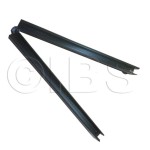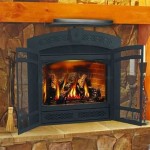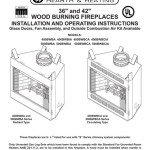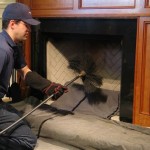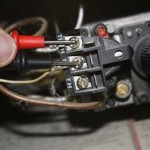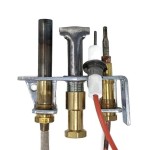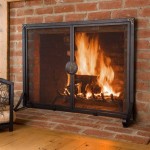Most Effective Fireplace Inserts
A fireplace insert is a self-contained heating unit designed to fit inside an existing masonry or factory-built fireplace. It transforms an inefficient, open fireplace into a powerful and efficient heating appliance. The effectiveness of a fireplace insert is determined by a variety of factors, including heating capacity, fuel type, efficiency rating, blower functionality, and safety features. Choosing the most effective fireplace insert for a particular application requires a thorough understanding of these factors and their impact on overall performance and user satisfaction.
The primary purpose of a fireplace insert is to provide supplemental heat to a home or specific area. Unlike traditional fireplaces, which often lose more heat than they produce due to draft and chimney losses, fireplace inserts are designed to maximize heat transfer and minimize energy waste. They achieve this through features such as airtight construction, insulated fireboxes, and efficient combustion systems. Understanding the principles behind their operation is crucial for selecting an insert that meets specific heating needs.
Heating Capacity and Firebox Size
The heating capacity of a fireplace insert is typically measured in British Thermal Units (BTUs). A BTU represents the amount of heat required to raise the temperature of one pound of water by one degree Fahrenheit. The appropriate BTU rating for an insert depends on the size of the area to be heated, the climate, and the insulation of the home. A larger space requires a higher BTU output. Manufacturers often provide guidelines for the square footage that a particular insert can effectively heat.
Firebox size is directly related to heating capacity. A larger firebox can accommodate more fuel, leading to a longer burn time and a higher BTU output. However, a larger firebox may also consume more fuel, potentially increasing operating costs. It is important to select a firebox size that is appropriate for the heating needs and fuel preferences of the homeowner. Considerations include the frequency of refueling and the availability of suitable fuel sources.
The type of fuel used also influences heating capacity. Wood-burning inserts, for example, may have different BTU outputs depending on the type and moisture content of the wood. Pellet inserts, which burn compressed wood pellets, typically offer consistent BTU outputs and automated fuel feeding systems. Gas inserts, on the other hand, provide convenient and controllable heating with a steady flame.
The efficiency of the insert plays a major role to the heat output since the energy of the fuel must be consumed efficiently. BTU output is not a good indicator if an insert has poor efficiency.
Efficiency Rating and Technologies
The efficiency rating of a fireplace insert indicates how effectively it converts fuel into usable heat. Efficiency is typically expressed as a percentage, with higher percentages indicating greater efficiency. Modern fireplace inserts boast significantly higher efficiency ratings compared to traditional fireplaces, which are notoriously inefficient.
Several technologies contribute to the improved efficiency of fireplace inserts. One such technology is secondary combustion, which involves burning the gases and particulates that are released during the primary combustion process. This secondary combustion reduces emissions and extracts additional heat from the fuel. Advanced combustion systems, often found in EPA-certified inserts, further optimize the burning process for maximum efficiency and minimal pollution.
Catalytic combustors are another technology used to enhance efficiency and reduce emissions. These devices use a catalyst to lower the ignition temperature of unburned gases, allowing them to burn more completely. Catalytic combustors can significantly reduce smoke and creosote buildup in the chimney, improving safety and reducing maintenance requirements. However, catalytic combustors require periodic maintenance and replacement to maintain optimal performance.
Zoning is another consideration since this may impact the BTU output and efficiency. Selecting an insert to heat one area versus a whole house requires different heating system selection and considerations.
Blower Functionality and Heat Distribution
A blower is a fan that circulates warm air from the fireplace insert into the room. It significantly enhances the insert's ability to distribute heat evenly and effectively. Without a blower, much of the heat generated by the insert would rise directly upward, concentrating the warmth near the ceiling. A blower helps to push the heated air outward, creating a more comfortable and consistent temperature throughout the space.
Blowers are typically powered by electricity and can be controlled manually or automatically. Manual controls allow the user to adjust the fan speed to regulate the airflow. Automatic controls, often found in more advanced models, use sensors to detect the temperature of the insert and automatically adjust the fan speed accordingly. This feature helps to maintain a consistent temperature and prevent overheating.
The effectiveness of a blower depends on its airflow capacity, which is measured in cubic feet per minute (CFM). A higher CFM rating indicates a greater ability to circulate air. The appropriate CFM rating for a blower depends on the size of the room and the heating capacity of the insert. When evaluating the blower, it's important to consider the noise level it generates. Some blowers can be quite loud, which can be disruptive. Look for models with variable speed controls or noise-dampening features to minimize noise.
Proper installation helps distribute heat from the insert effectively as well. The best insert can be less effective if installed poorly.
Fuel Type Considerations
Fireplace inserts are designed to burn various fuel types, including wood, gas, and pellets. Each fuel type offers distinct advantages and disadvantages in terms of cost, convenience, and environmental impact. The most effective fuel type for a particular application depends on individual preferences and priorities.
Wood-burning inserts are a popular choice for those who appreciate the ambiance of a traditional wood fire. Wood is a renewable resource, and wood-burning inserts can be an economical heating option, especially if the homeowner has access to a readily available and affordable wood supply. However, wood-burning inserts require manual fueling and create ash, which must be regularly removed. Wood storage and handling can also be a chore for some homeowners.
Gas inserts offer convenience and ease of use. They can be turned on and off with the flick of a switch and do not require manual fueling or ash removal. Gas inserts typically burn either natural gas or propane. Natural gas is generally less expensive than propane, but it may not be available in all areas. Gas inserts offer precise temperature control and can be equipped with features such as remote controls and programmable thermostats. They do require a gas line connection, which may involve professional installation.
Pellet inserts burn compressed wood pellets, which are typically made from recycled wood waste. Pellet inserts offer a balance of convenience and efficiency. They can be automatically fueled using a hopper and auger system, which allows for extended burn times without manual intervention. Pellet inserts produce relatively low emissions and generate minimal ash. However, they require electricity to operate the auger and blower, and the cost of pellets can fluctuate depending on market conditions.
The local air quality regulations also impact the type of fuel and insert to be purchased. Some cities and states have restrictions on wood burning during certain times of the year.
Safety Features and Certifications
Safety is paramount when selecting a fireplace insert. Look for inserts that are certified by reputable organizations such as the Environmental Protection Agency (EPA) and Underwriters Laboratories (UL). EPA certification indicates that the insert meets stringent emissions standards, while UL certification confirms that it has been tested and meets safety requirements.
Key safety features to consider include a sealed combustion chamber, which prevents the escape of harmful gases into the home, and a safety shut-off system, which automatically shuts off the insert in the event of a malfunction or overtemperature condition. A carbon monoxide detector is also essential, as carbon monoxide is a colorless, odorless gas that can be deadly.
Proper installation is crucial for ensuring the safe and efficient operation of a fireplace insert. It is important to have the insert installed by a qualified professional who is familiar with local building codes and safety regulations. The installer should thoroughly inspect the existing chimney to ensure that it is in good condition and properly sized for the insert. A chimney liner may be necessary to prevent creosote buildup and protect the chimney from corrosion.
Regular maintenance is also essential for maintaining the safety and performance of a fireplace insert. This includes cleaning the chimney regularly to remove creosote, inspecting the insert for any signs of damage or wear, and replacing any worn or damaged components as needed. Following the manufacturer's recommendations for maintenance and operation will help to ensure the long-term safety and efficiency of the fireplace insert.
Inserts must also be installed according to the setback requirements. Make sure to avoid combustible materials near the unit to mitigate any fire hazards.
Cost Considerations Including Installation
The cost of a fireplace insert can vary widely depending on the fuel type, features, and brand. Wood-burning inserts are typically the least expensive, while gas and pellet inserts tend to be more costly. Consider the long-term operating costs, including the cost of fuel and maintenance, when evaluating the overall cost of an insert.
Installation costs can also add significantly to the overall cost. Installation typically includes the cost of the insert itself, as well as the cost of labor, materials, and any necessary modifications to the existing fireplace and chimney. The cost of installation can vary depending on the complexity of the installation and the location of the home. It is important to obtain quotes from multiple installers to ensure that you are getting a fair price.
Beyond the initial purchase and installation costs, there are ongoing operating costs to consider. These include the cost of fuel, electricity (for blowers and automated systems), and maintenance. Wood-burning inserts require a regular wood supply, which can be sourced from a variety of locations. Gas inserts require a gas line connection, which may incur monthly charges. Pellet inserts require a supply of wood pellets, which can be purchased in bulk or individually. Regular chimney cleaning and maintenance are also necessary to ensure the safe and efficient operation of the insert.
Finally, the cost of running an insert can be impacted by the local climate. If the winter temperatures are mild, then the amount of fuel consumption is lower. The insulation of a building is also a factor, since better insulation means less heat loss and thus lower fuel consumption.

Fireplace Inserts 5 Money Saving Benefits Efficient Heating

Why A Wood Burning Fireplace Insert Bethesda Md Service

Wood Burning Fireplace Inserts Insert Installation

Best Gas Fireplace Inserts Fireplaces Direct Learning Center

9 Best Electric Fireplace Inserts Of 2024 Tested And Reviewed

Regency Pro Series Ci2700 Wood Insert Toronto Best Fireplaces

The Best Wood Burning Fireplace Inserts Or Stoves Ecohome

9 Best Electric Fireplace Inserts Of 2024 Tested And Reviewed

Comparing Fireplace Inserts What S Best For You Forge Flame
.aspx?strip=all)
Top 11 Gas Fireplace Insert Trends Of 2024
Related Posts

